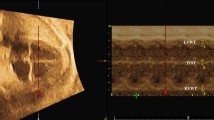Abstract
Purpose
Spatiotemporal image correlation (STIC) is an excellent imaging modality for observing the fetal heart. High-quality STIC volume data are needed for an antenatal anatomic survey to diagnose congenital heart disease. We aimed to clarify the causes of unsuccessful STIC volume data acquisition and describe a more accurate, efficient STIC examination.
Methods
This cross-sectional study of 1124 women with fetuses assessed risk factors for unsuccessful acquisition of STIC volume data. Logistic regression analysis quantified the relation between unsuccessful acquisition and clinical variables, including maternal body mass index (BMI), shadowing artifacts due to unexpected fetal limb movement (SAU), estimated fetal weight (EFW), gestational age (GA), use of volume rendering images in four-dimensional ultrasonography (4D-US), fetal heart rate (FHR), maternal age, anterior placenta, and prior lower abdominal surgery.
Results
STIC volume data acquisition was unsuccessful in 210 of 1124 (18.6%) cases. SAU, BMI ≥ 28 kg/m2, not using volume rendering images in 4D-US, EFW ≥ 1300 g, and anterior placenta were independent risk factors for unsuccessful STIC data acquisition.
Conclusions
Avoiding SAU was the most important factor for accurate, efficient STIC evaluations for diagnosing congenital heart disease antenatally. The risk was not explained by lack of sonographer proficiency. Volume rendering images in 4D-US is a promising approach to successful acquisition of STIC volume data.







Similar content being viewed by others
References
Hata T, Dai SY, Inubashiri E, et al. Four-dimensional sonography with B-flow imaging and spatiotemporal image correlation for visualization of the fetal heart. J Clin Ultrasound. 2008;36:204–7.
Gonçalves LF, Lee W, Chaiworapongsa T, et al. Four-dimensional ultrasonography of the fetal heart with spatiotemporal image correlation. Am J Obstet Gynecol. 2003;189:1792–802.
Bennasar M, Martínez JM, Gómez O, et al. Accuracy of four-dimensional spatiotemporal image correlation echocardiography in the prenatal diagnosis of congenital heart defects. Ultrasound Obstet Gynecol. 2010;36:458–64.
Uittenbogaard LB, Haak MC, Spreeuwenberg MD, et al. A systematic analysis of the feasibility of four-dimensional ultrasound imaging using spatiotemporal image correlation in routine fetal echocardiography. Ultrasound Obstet Gynecol. 2008;31:625–32.
Rizzo G, Capponi A, Pietrolucci ME, et al. Satisfactory rate of postprocessing visualization of standard fetal cardiac views from 4-dimensional cardiac volumes acquired during routine ultrasound practice by experienced sonographers in peripheral centers. J Ultrasound Med. 2011;30:93–9.
Cohen L, Mangers K, Grobman WA, et al. Satisfactory visualization rates of standard cardiac views at 18–22 weeks’ gestation using spatiotemporal image correlation. J Ultrasound Med. 2009;28:1645–50.
Gonçalves LF, Lee W, Espinoza J, et al. Examination of the fetal heart by four-dimensional (4D) ultrasound with spatio-temporal image correlation (STIC). Ultrasound Obstet Gynecol. 2006;27:336–48.
DeVore GR, Falkensammer P, Sklansky MS, et al. Spatio-temporal image correlation (STIC): new technology for evaluation of the fetal heart. Ultrasound Obstet Gynecol. 2003;22:380–7.
Novaes JY, Zamith MM, Araujo Júnior E, et al. Screening of congenital heart diseases by three-dimensional ultrasound using spatiotemporal image correlation: influence of professional experience. Echocardiography. 2016;33:99–104.
Wang N, Xie HN, Peng R, et al. Accuracy, agreement, and reliability of fetal cardiac measurements using 4-dimensional spatiotemporal image correlation. J Ultrasound Med. 2012;31:1719–26.
AIUM practice guideline for the performance of fetal echocardiography. J Ultrasound Med. 2013;32:1067–82.
Black KJ, Pusic MV, Harmidy D, et al. Pediatric intravenous insertion in the emergency department: bevel up or bevel down? Pediatr Emerg Care. 2005;21:707–11.
Peduzzi P, Concato J, Kemper E, et al. A simulation study of the number of events per variable in logistic regression analysis. J Clin Epidemiol. 1996;49:1373–9.
Hanley JA, McNeil BJ. The meaning and use of the area under a receiver operating characteristic (ROC) curve. Radiology. 1982;143:29–36.
Feldman MK, Katyal S, Blackwood MS. US artifacts. Radiographics. 2009;29:1179–89.
Acknowledgements
We express our gratitude to all members of the clinical laboratory in our hospital.
Author information
Authors and Affiliations
Corresponding author
Ethics declarations
Conflict of interest
The authors have no conflicts of interest to declare.
Ethical standards
All procedures followed were in accordance with the ethical standards of the responsible committees on human experimentation (institutional and national) and with the Helsinki Declaration of 1975, as revised in 2008. Informed consent was obtained from all patients to be included in the study.
About this article
Cite this article
Inubashiri, E., Tatedo, S., Nishiyama, N. et al. Feasibility assessment for successfully visualizing the fetal heart utilizing spatiotemporal image correlation. J Med Ultrasonics 45, 269–279 (2018). https://doi.org/10.1007/s10396-017-0818-1
Received:
Accepted:
Published:
Issue Date:
DOI: https://doi.org/10.1007/s10396-017-0818-1




